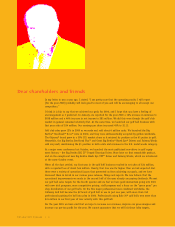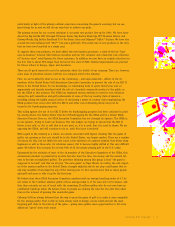Callaway 2000 Annual Report Download - page 11
Download and view the complete annual report
Please find page 11 of the 2000 Callaway annual report below. You can navigate through the pages in the report by either clicking on the pages listed below, or by using the keyword search tool below to find specific information within the annual report.
Callaway Golf Company | 5
particularly in light of the gloomy outlook some have concerning the general economy, but we see
good things for us and we will do our very best to achieve our goals.
The primary reason for our current optimism is our great new product line-up for 2001. We have intro-
duced the Big Bertha ERC II Forged Titanium Driver, Big Bertha Hawk Eye VFT Titanium Drivers and
Fairway Woods, Big Bertha Steelhead X-14 Pro Series Irons and Odyssey® TriHot™ Putters. We have also
created the new Callaway Golf “CB1™” two-piece golf balls. This entire line of new products is the very
best we have ever launched in a single year.
To support these new products, we have added two new business processes: a state-of-the-art “busi-
ness-to-business” internet link between ourselves and our U.S. retailers; and a fantastic new collection
of “store-in-store” retail fixtures for those customers. In addition we now have an outside sales force in
the U.S. that is about 50% larger than we had at the start of 2000. Similar improvements are planned
for future rollout in Europe, Japan and elsewhere.
These are all good reasons for us to be optimistic about the health of our company. There are, however,
some areas of potential concern, both for our company and for the industry.
First, we are troubled by what we see as the continuing – and unprecedented – efforts of the 16
members of the United States Golf Association Executive Committee to prevent the sale of our ERC II
Driver in the United States. To our knowledge, no rulemaking body in sports history has ever so
aggressively and directly interfered with the sale of a branded commercial product to the public as
has the USGA in this instance. The USGA has employed various methods to exert its vast influence
among the golf committees and golf professionals of some of the top country clubs of America –
including taking the highly unusual action of circulating a memo to country clubs emphasizing the
USGA position that scores shot with the ERC II and other non-conforming drivers may not be
turned in for handicapping purposes.
This ruling against the use of our ERC II Driver for handicapping purposes has been criticized in print
by, among others, the former Senior Director of Handicapping for the USGA and by a former USGA
Executive Director. Even so, the USGA Executive Committee has not changed its opinion. The USGA is,
in our opinion, trying to harm our business. The rule makers are trying to ensure that the ERC II
Driver is not sold, or, if it is sold that it is not used, or, if it is used, that it is used in shame. We are
opposing the USGA, and will continue to do so, until this issue is resolved.
With regard to the industry as a whole, we remain concerned with figures showing that the game of
golf is not growing as fast as it should be in the United States, our largest market. There are a number
of reasons for this, but we think the root cause is the existence of a general mindset that drives away
beginners as well as those who, for whatever reason, fail to become highly skilled at this very difficult
game. We believe this accounts for at least 95% of all the people playing golf in the U.S. today.
Epitomized by the attitudes of most of the 16 members of the Executive Committee of the USGA, this
exclusionary mindset is promoted by an elite few who have the time, the money and the natural tal-
ents to become accomplished golfers. The prevalent thinking among this group is that “the game is
supposed to be hard” and that we all play “the same game” as Tiger Woods. In reality, the vast majori-
ty of the amateur golfers in the United States struggle mightily and do not play a golf game that in
any way resembles that played by any of the touring pros. In fact, reports show that as many people
quit golf each year as take it up for the first time.
We believe that these USGA Executive Committee members with an average handicap index of 4.7 do
not relate to the 5 million amateur golfers whose average index is 17 for men and 31 for women, and
that they certainly are out of touch with the remaining 20 million golfers who do not even have an
established handicap index. We believe these 16 people are making the rules for the elite few rather
than in the interest of growing this wonderful game.
Callaway Golf has always believed that the way to grow the game of golf is to make it more enjoyable
for the average golfer. That is why we have always tried to design, create, build and sell the most
forgiving golf clubs in the history of the game – giving more golfers more opportunities to hit a few
additional “great” shots each round.
























